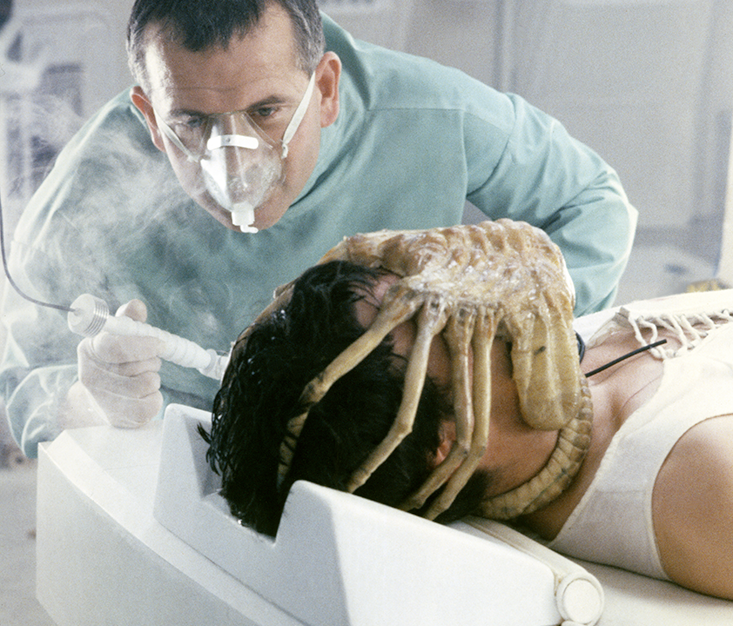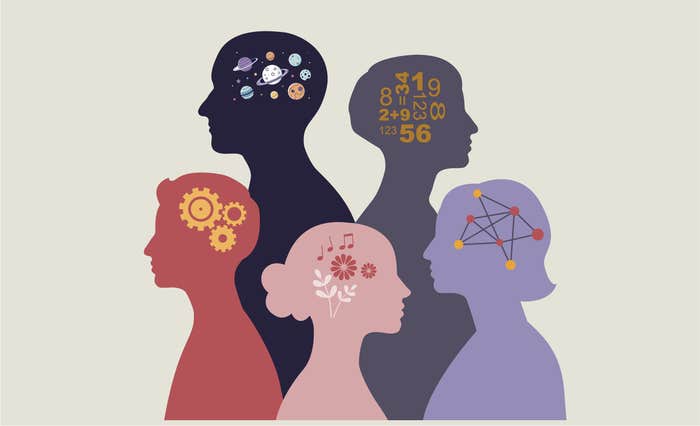I was 13 years old when the movie Alien was released. It scared me into a month-long spell of anxiety. The hair on the back of my neck was perpetually up and I had the jittery demeanor of a combat veteran. While the full-grown xenomorph alien was chilling, the larval stage face-hugger was terrifying. Not only did it penetrate the human host’s throat, planting the chest-burster in the gut, but it was intrinsically grotesque, an odious, zoological mash-up of scurrying spider and slithering snake.
It’s easy to interpret our fears of alien predators as nothing more than superficial horror ginned up by the Hollywood fright machine. But they also reveal important truths about human cognition and cultural evolution. We are wired for emotional jolts and these feelings have adaptive benefits. My paralyzing dread of the face-hugger in Alien may be a vestige of ancestral primate experiences with snakes and spiders. But the hybrid nature of the Alien monster takes us deeper into ourselves and history.

Every culture, it seems, has monstrous mash-ups in their folklore and religion. Composite creatures appear in our earliest literature and turn up in Upper Paleolithic cave paintings. The sphinx in Giza, half-human and half-lion, is at least 4,500 years old. In the Epic of Gilgamesh (2100 B.C.), heroes Gilgamesh and Enkidu battle a hybrid monster named Humbaba, described as having a lion’s head and hands, but a scaly body. Vishnu, in India, manifests as a fierce lion-man monster, Narasimha, in several Hindu texts. Ganesha, son of Shiva, is humanoid with an elephant head. The many Greek hybrid creatures—centaurs, satyrs, mermaids, Pegasus, Hydra, griffins, chimeras—are constantly resurrected in Hollywood. Literature over the last two millennia, from Beowulf to Tolkien to Rowling, has added countless composite creatures and shape-shifters. More recently we have regular hybridizing of humans and computers.
So why all the taxonomic mashing and mixing? Humans have an innate or an early developmental folk taxonomy of the world, according to psychologist Dan Sperber and anthropologist Pascal Boyer. We have a way of organizing the world into predictable categories for easy understanding, cognition, and manipulation. Even as small children, we seem capable of grouping people, birds, bugs, trees, and fish together into kinds—similar within their category but dissimilar across categories. Not only do kids tend to see whales as “fish,” but early natural history made this error too. Our folk taxonomy concerning whales reveals the unsophisticated quality of our natural classifications; if it swims in the water and looks like a fish, it’s a fish. To give our brains credit, however, our pre-scientific ancestors didn’t need a more nuanced understanding of whales, and we had as much knowledge about them as was probably necessary for survival.
Most monsters function as disgusting threats that heroes and gods vanquish, repudiate, and cleanse from the community.
Most humans seem to share very broad mental categories of taxonomy, like “animal,” “inanimate object,” but also further distinctions like “slithering animals,” “flying animals,” and “four-legged animals.” Whether these are innate or learned, the adult mind uses these mental categories in processing daily experience. The brain employs the categories to parse the “blooming, buzzing confusion” of sensory information. We call this the “predictive processing theory of cognition,” emphasizing the brain’s pattern-recognition system. Our brains create predictive models of the world that help us extract useful signals from ambient informational noise.
Category violations strongly arouse the human mind. When our expectations about the world—“humans have two arms,” “snakes don’t fly”—are disrupted by Vishnu, with dozens of arms, or flying snakes in the form of dragons, the images grab our attention and become cognitively “sticky.” They stick in our memories, recall very easily, and spread throughout the social group. Hybrid monsters, in other words, make excellent memes. Richard Dawkins first argued that while memes were cultural fragments or cognitive units, they were analogical to genes in the sense that they spread through populations without conscious design or purpose. Unnatural ideas or images survive and spread well because they surprise us, making them harder to forget or ignore.
Anthropologist David Wengrow argues that hybrid monsters proliferated during the Bronze Age, because new trade routes and cultural mixing elicited psychological anxiety. Creating monsters is a way of channeling our cultural and political fears into tangible forms, into objects of loathing and dread.
Monsters might not seem like helpful memes because they frighten us and increase stress, but they are almost always part of a larger cultural cautionary tale. The monster plays an important role in norm enforcement. If you don’t follow the rules, the bogeyman will get you. If you don’t walk the path of virtue, the devil will take you. If you succumb to gluttony, you’ll become a “hungry ghost” in the next life (according to Buddhist traditions). Most monsters function as disgusting threats that heroes and gods vanquish, repudiate, and cleanse from the community. They offer surrogate rehearsals for how the real community (“us”) will resist actual enemies (“them”). Monsters are sticky memes that draw groups together into moral communities.
This means that fantasy helps make some of the core elements of culture itself, because monsters and heroes create social solidarity through cultural kinship. The counterfactual nature of fantasy is one of the earliest and most effective ways to create cultural kinship. Early human groups grew to social scales beyond genetic kinship, and culture helped create fictive kin groups. Non-relatives would feel like brothers: cooperating effectively, sharing resources, and killing and dying for each other. Fictive kin groups don’t rally around abstract or rational ethical principles, but they do rally around rituals and cults of Vishnu, or Jesus, or Sun Wukong, or animistic spirits. They rally around hybrids and other sticky memes.
The story of cognitive hybrids has long focused on the evolution of religion. Religion emerges out of cognitive precursors (or pre-adaptations) like folk taxonomy. If our folk categories carve the world into predictable patterns, then occasional category mismatches will spark unique cognitive arousal, producing supernaturalism. Artifacts that speak, or dead creatures that live again, consist in relatively simple category transpositions. Our brain’s predictive patterns get mixed up. And these same category mash-ups produce the creatures of horror.
The theory of category mismatch, though, often lacks the emotional ingredient. It’s not enough to assume that upending cognitive categories suddenly produces a supernatural entity. We have a concept of dog in our heads, but imagining a dog with three heads doesn’t produce the horrible impact of Cerberus. Rather, the content of cognitive categories contains emotional tone from the beginning. Most objects, animals, and people we encounter in daily life trigger low-level feelings of “approach” or “avoid.” But the emotional aspect of a category like “slitherers” or “crawlers” is especially dramatic.
When we conceptualize gods or monsters or other memes, those concepts are infused with shades of fear, or lust, or anger, and complex mixtures of these. Emotions are the oldest form of coding the world into dangerous and beneficial categories. We share this early coding system with other mammals.

Emotional associations are built into our folk taxonomy. While category mismatches arouse our curiosity and improve memory retention, hybrids that carry strong emotional associations (like arachnophobia) will be especially sticky. Effective horror (and religion) has figured out symbols and stories that unconsciously trigger our primitive emotions. As cultural theorist Mathias Clasen argues in his book Why Horror Seduces, similar monsters and horror stories work well on people of very different cultural backgrounds. Horror has universal power. In part, this is because human cognition is universally governed by those folk taxonomy categories, so violations will arouse anyone from Manhattan to Morocco. But more important are the universal emotional systems that link natural predator fear and dread with cultural images.
All mammals are equipped with adaptive instincts like fight or flight, but these are old-brain systems, housed primarily in the brainstem. The emotional circuits of the brain (including limbic areas like the amygdala, hypothalamus, and hippocampus) are interwoven with instinctual motor systems as well as our higher cognition. The late neuroscientist, Jaak Panskepp, a pioneer in the study of emotions and mammals, located seven major emotional systems that mammals share: fear, care, lust, rage, panic, seeking, and play. Each of these circuits has unique pathways through the brain, enlists specific neurotransmitters and hormones, and results in specific mammal behaviors. Fear, for example, has a neurocircuitry that passes from the amygdala through the hypothalamus to the brainstem and out through the spinal cord.
Our brain’s predictive patterns get mixed up. And these same category mash-ups produce the creatures of horror.
Like any other biological trait, fear is subject to evolution. Darwin repeatedly brought snakes (real and fake) down to the London Zoo primate house. He discovered that chimps had an extreme fear of snakes, and wondered how they possessed such a useful dread of threatening species. How could experiential information about snakes be stored in primate DNA for future transmission?
The category violation hypothesis skirts this problem beautifully. Fear comes from any hybrid cognition or category-jamming and not from the content of the cognition. The cognitive tangle creates the emotional arousal, not the animal or monster itself. Of course, not every mash-up strikes fear in the viewer. I’m not terrified of Walt Disney’s ballet-dancing hippopotamus or Thomas the Tank Engine. Moreover, emotions like fear seem dedicated to certain environmental threats, and fear operates faster and more powerfully than mere taxonomy confusion.
It could be that fear of creepy crawlies was never “acquired” from conditioned learning, observation, or experience. Hominids that had a random fear response coupled with the perception of spiders lived to reproduce better than the hominids who had a random fear response coupled with the sight of trees. Fear makes you run away and running away from poisonous spiders is more adaptive than running away from harmless trees. In this view, all humans have an inherited synapse coding that mechanically paints spider-shaped perceptions with fear, independent of “learning” (observing the harm that poisonous spiders do). If the brain makes an epinephrine-soaked spider-shaped predictive pattern, then we run and live long enough to reproduce it.
Psychologists Donald Hebb and Wolfgang Schleidt separately experimented on fear in animals and found that fear is not a result of a hardwired phobia of specific predators, but a developmental pairing of our categories and our feelings. When birds and mammals are born they have flexible categories that store associations. But these categories solidify quickly after birth and become default ways of interpreting the world. When any strange creature appears (one not corresponding to the default categories), the subject becomes aroused and fearful. By exposing songbirds to hawk shapes early on (hawks are natural predators) researchers eliminated their hawk fear, but late exposure to goose shapes (no threat) produced fear responses in the songbirds.
According to psychologist Mary Ainsworth’s “strange situation” experiments, human default categories solidify around 6 months old, and babies after that time are much more frightened by anything “strange.” If human babies spent most of their first year strapped to their mothers or otherwise protected (and off the ground), then creepy crawlies of every variety would, once encountered, radically disturb the default taxonomy laid down in the child’s first six months.
This work on cognitive and emotional development explains why there is a relatively small number of universal human phobias, including arachnophobia (fear of spiders), herpetophobia (fear of snakes), nyctophobia (fear of the dark), and a few others like fear of murky or deep water. However, once culture starts hybridizing these elements in religion and horror, the images become extremely sticky memes.
It’s no wonder, then, the face-hugger in Alien struck terror in me—and still does. Not only does it spark primeval brain processes, but it also binds me to my cultural heritage, and my very species. Following earlier religious and literary traditions, Hollywood horror unconsciously taps this same deep biocultural reservoir.
Stephen T. Asma is a professor of philosophy at Columbia College Chicago, and a senior fellow of the Research Group in Mind, Science and Culture. He is author of 10 books, including On Monsters: An Unnatural History of Our Worst Fears, and, most recently, The Evolution of Imagination.
This article was originally published in our “Monsters” issue in October, 2017.


























